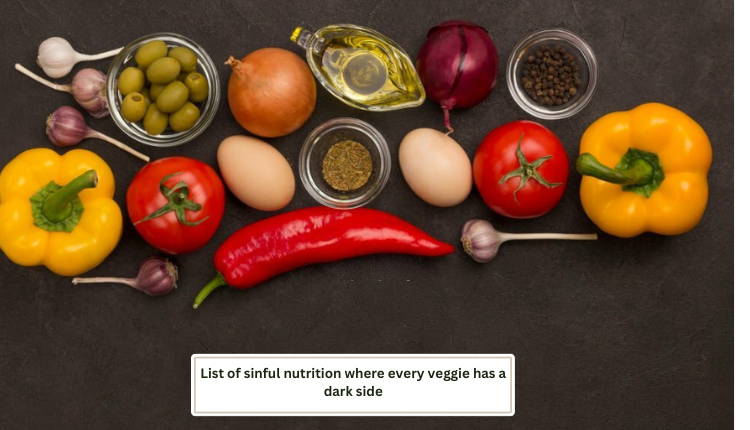Table of Contents
What is Sinful Nutrition?
Explore the darkish aspect of vegetables in “Sinful Nutrition Where Every Veggie Has a Dark Side” Discover the hidden truths approximately starchy, nightshade, cruciferous, goitrogenic, high-calorie, and poisonous greens. Learn how these greens can affect your health and make knowledgeable dietary picks.
Heroes or Zeros
When it comes to vitamins, vegetables are often hailed as the heroes of our weight-reduction plan. However, in this exploration of “Sinful Nutrition Where Every Veggie Has a Dark Side,” we delve into the lesser-recognized aspects of certain vegetable organizations. Join us as we discover the hidden truths approximately starchy, nightshade, cruciferous, goitrogenic, high-calorie, and toxic veggies. Knowledge is power, and expertise in this Sinful Nutrition Where Every Veggie Has a Dark Side facet allows you to make extra knowledgeable choices on your health.
Starchy Vegetables
Starchy greens like potatoes, corn, and peas are beloved staples in lots of diets. However, their excessive carbohydrate content material can cause spikes in blood sugar levels. These vegetables should be eaten up sparsely, especially by individuals with diabetes or those seeking to control their weight successfully.

Nightshade Vegetables
In Sinful Nutrition Where Every Veggie Has a Dark Side, Nightshade veggies, inclusive of tomatoes, peppers, and eggplants, comprise alkaloids that can cause inflammatory responses in some people. While they provide numerous fitness blessings, those with sensitivity or autoimmune conditions should work caution when such as nightshades in their Food Plan.
Cruciferous Vegetables
Cruciferous veggies inclusive of broccoli, cauliflower, and Brussels sprouts are filled with nutrients and most cancers-fighting compounds. However, overconsumption can lead to digestive pain due to their high fiber and sulfur content material. Balancing your consumption is fundamental to reaping their benefits.

Goitrogenic Vegetables
Goitrogenic veggies like kale, spinach, and cabbage include compounds that could interfere with thyroid characteristics while eating excessively. If you have got into trouble, it’s essential to cook dinner with some veggies to reduce their goitrogenic outcomes.
High-Calorie Vegetables
While most vegetables are low in energy, a few, like avocados and olives, are exceptions. These excessive-calorie vegetables offer wholesome fats however must be eaten mindfully, especially if you’re watching your calorie consumption.
Toxic Vegetables
Certain veggies include pollution whilst fed on uncooked or improperly organized. For instance, cassava carries cyanogenic glycosides, which could release cyanide. Proper cooking techniques are critical to neutralize those toxins.
Related Post Simply Lemonade Nutrition Facts
The Deceptive Glow: Vegetables and Their Hidden Dangers
It’s a common belief that vegetables are universally beneficial, but the reality is more complex. While they are packed with essential nutrients, some vegetables come with their own set of drawbacks. Let’s shed light on these hidden dangers:
1. Oxalates and Kidney Stones
In Sinful Nutrition Where Every Veggie Has a Dark Side, Do you know that spinach, a beloved leafy green, contains oxalates that can contribute to kidney stone formation? It’s crucial to moderate your intake, especially if you’re prone to this painful condition.

2. High-Fructose Corn Syrup in Canned Vegetables
Canned vegetables may seem convenient, but they often contain high-fructose corn syrup, which can lead to weight gain, diabetes, and heart problems. Fresh or frozen options are a healthier choice.
3. Lectins in Raw Legumes
Raw legumes like kidney beans and lentils contain lectins, which can be toxic in large quantities. Proper cooking is essential to neutralize these harmful compounds. That is why it is included in Sinful Nutrition Where Every Veggie Has a Dark Side.
4. Nightshades and Inflammation
Tomatoes, potatoes, and peppers belong to the nightshade family, which can trigger inflammation in some individuals. If you have arthritis or other inflammatory conditions, be cautious with these veggies.

5. Pesticide Residues
Non-organic vegetables may carry pesticide residues that can harm your health over time. Washing thoroughly or choosing organic options can reduce this risk.
Expert Insights: Sinful Nutrition Where Every Veggie Has a Dark Side
To get rid of Sinful Nutrition Where Every Veggie Has a Dark Side and To gain a more balanced understanding of vegetable consumption, we turned to nutrition experts who shared their valuable insights:
Dr. Emily Turner, Nutritionist
eXPERTS TALKING ABOUT Sinful Nutrition Where Every Veggie Has a Dark Side. “Vegetables are undeniably essential for a balanced diet. However, it’s crucial to be aware of individual responsive qualities and ailments. Moderation and variety are key.”

Chef Michael Harris, Culinary Expert
“As a chef, I encourage people to explore different cooking methods and flavor combinations with vegetables TO get aware of Sinful Nutrition Where Every Veggie Has a Dark Side. This not only enhances taste but also maximizes their nutritional benefits.”
FAQs
What dark green vegetables should I eat at least three to four times a week?
Aim to consist of loads of darkish green vegetables in your food plan, consisting of spinach, kale, broccoli, collard veggies, and Swiss chard. These nutrient-wealthy alternatives offer critical nutrients and minerals for typical fitness.
What is the number 1 healthiest vegetable?
While it is tough to pinpoint a single “healthiest” vegetable, broccoli frequently tops the list because of its amazing dietary profile. It’s rich in fiber, vitamins, and antioxidants, making it an outstanding desire for a wholesome weight loss plan.
What nutrients do vegetables from the dark green subgroup provide a wealth of?
Sinful Nutrition Where Every Veggie Has a Dark Side and Dark inexperienced vegetables are an excellent supply of numerous nutrients, however, they particularly excel in imparting an abundance of folate (a B-vitamin), nutrition K, diet A, and critical minerals like iron and calcium. These vitamins are important for preserving true fitness and well-being.
What happens if you don’t eat vegetables?
If you do not consume greens often, you could pass over on essential vitamins, minerals, fiber, and antioxidants that play an essential role in helping your overall health. A loss of veggies on your weight loss plan can result in nutrient deficiencies, digestive problems, and an extended threat of continual sicknesses. It’s essential to include quite a few greens in your food to make certain you obtain the blessings they provide.




